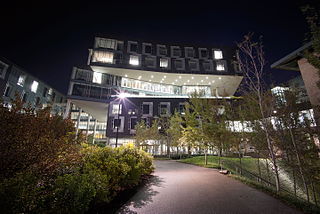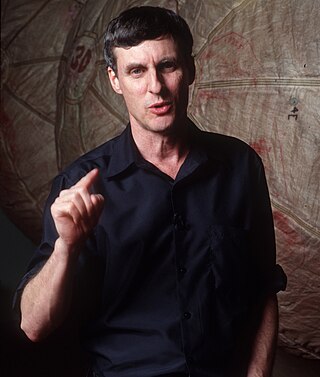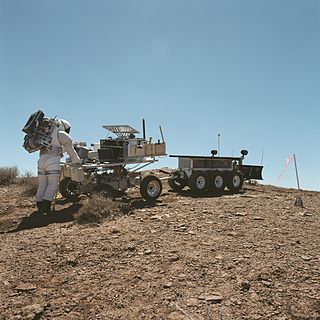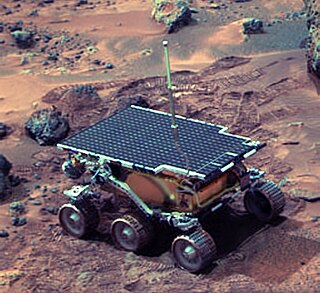This article needs to be updated.(November 2011) |
Intelligent Robotics Group (IRG) is a division of the Ames Research Center at Moffett Federal Airfield in California's Silicon Valley. [1]
This article needs to be updated.(November 2011) |
Intelligent Robotics Group (IRG) is a division of the Ames Research Center at Moffett Federal Airfield in California's Silicon Valley. [1]
The 2009 Director of the Intelligent Robotics Group Terry Fong stated in an interview that:
IRG conducts applied research in a wide range of areas, including computer vision, geospatial data systems, human–robot interaction, interactive 3-D visualization and robot software architecture. In 2009, we co-developed "Mars in Google Earth" and "Moon in Google Earth" with Google; we remotely operated one of our K10 planetary rovers to scout portions of Black Point Lava Flow (in Arizona); and we used our GigaPan robotic camera for science, education and journalism. [2]
The Intelligent Robotics Group (IRG) explores extreme environments, remote locations, and uncharted worlds [and] conduct[s] applied research in computer vision, geospatial data systems, human-robot interaction, planetary mapping and robot software.
— IRG brochure [3]

The Ames Research Center (ARC), also known as NASA Ames, is a major NASA research center at Moffett Federal Airfield in California's Silicon Valley. It was founded in 1939 as the second National Advisory Committee for Aeronautics (NACA) laboratory. That agency was dissolved and its assets and personnel transferred to the newly created National Aeronautics and Space Administration (NASA) on October 1, 1958. NASA Ames is named in honor of Joseph Sweetman Ames, a physicist and one of the founding members of NACA. At last estimate NASA Ames had over US$3 billion in capital equipment, 2,300 research personnel and a US$860 million annual budget.

The Nomad rover is an uncrewed vehicle designed as a test for such a vehicle to ride on other planets.

The School of Computer Science (SCS) at Carnegie Mellon University in Pittsburgh, Pennsylvania, US is a school for computer science established in 1988. It has been consistently ranked among the top computer science programs over the decades. As of 2022 U.S. News & World Report ranks the graduate program as tied for second with Stanford University and University of California, Berkeley. It is ranked second in the United States on Computer Science Open Rankings, which combines scores from multiple independent rankings.

Steven Weldon Squyres is an American geologist and planetary scientist. He was the James A. Weeks Professor of Physical Sciences at Cornell University in Ithaca, New York. His research area is in planetary sciences, with a focus on large solid bodies in the Solar System such as the terrestrial planets and the moons of the Jovian planets. Squyres was the principal investigator of the Mars Exploration Rover Mission (MER).
Zoë is a solar-powered autonomous robot with sensors able to detect microorganisms and map the distribution of life in the Atacama Desert of northern Chile, duplicating tasks that could be used in future exploration of Mars. Zoë is equipped with tools and sensors to search for direct evidence of life beneath the surface of the ground. Zoë significantly aids in research needed to study Mars because it acts as a mobile observer and analyzer of any signs of life in a given location. She collects primary data which will help in understanding conditions present on Mars. This project will verify reliability of autonomous, mobile, and scientifically made robots.

Pascal Lee is co-founder and chairman of the Mars Institute, a planetary scientist at the SETI Institute, and the Principal Investigator of the Haughton-Mars Project (HMP) at NASA Ames Research Center in Mountain View, California. He holds an ME in geology and geophysics from the University of Paris, and a PhD in astronomy and space sciences from Cornell University.

William L. "Red" Whittaker is an American roboticist and research professor of robotics at Carnegie Mellon University. He led Tartan Racing to its first-place victory in the DARPA Grand Challenge (2007) Urban Challenge and brought Carnegie Mellon University the two million dollar prize. Previously, Whittaker also competed in the DARPA Grand Challenge, placing second and third place simultaneously in the Grand Challenge Races.

GigaPan Systems is a global, privately held technology company that provides hardware, software, and services to create and share high-resolution, interactive gigapixel panoramic images. The company is headquartered in Portland, Oregon.
Ekaterini Panagiotou Sycara is a Greek computer scientist. She is an Edward Fredkin Research Professor of Robotics in the Robotics Institute, School of Computer Science at Carnegie Mellon University internationally known for her research in artificial intelligence, particularly in the fields of negotiation, autonomous agents and multi-agent systems. She directs the Advanced Agent-Robotics Technology Lab at Robotics Institute, Carnegie Mellon University. She also serves as academic advisor for PhD students at both Robotics Institute and Tepper School of Business.

NASA's Desert Research and Technology Studies is a group of teams which perform an annual series of field trials seeking to demonstrate and test candidate technologies and systems for human exploration of the surface of the Moon, Mars, or other rocky bodies.
Almost Human: Making Robots Think is a book written by Lee Gutkind founder of Creative Nonfiction. Gutkind spent six years as a "fly on the wall" researcher at the Robotics Institute at Carnegie-Mellon University in Pittsburgh. He observed scientists and students working to design, build, and test robots so advanced that they will one day be able to work alongside or, in some cases, even replace humans. Almost Human is an intense portrait of the robotic subculture and the challenging quest for robot autonomy. Almost Human is 330 pages long and is published by W.W. Norton. In May 2007 Gutkind appeared as a guest author on The Daily Show with Jon Stewart to talk about robots, the future, and his book.

K10 are rovers used to explore planetary surfaces. Each third-generation K10 has four-wheel drive, all-wheel steering and a passive averaging suspension. This helps reduce the motion induced by travel over uneven ground. The K10 has mounting points on its front, back, and bottom that allows for antennas, sensors, and other scientific instruments to be attached. The K10 controller runs on a Linux laptop and communicates via 802.11g wireless, or a Tropos mesh wireless.
William J. Clancey is an American computer scientist who specializes in cognitive science and artificial intelligence. He has worked in computing in a wide range of sectors, including medicine, education, and finance, and had performed research that brings together cognitive and social science to study work practices and examine the design of agent systems. Clancey has been described as having developed “some of the earliest artificial intelligence programs for explanation, the critiquing method of consultation, tutorial discourse, and student modeling,” and his research has been described as including “work practice modeling, distributed multiagent systems, and the ethnography of field science.” He has also participated in Mars Exploration Rover mission operations, “simulation of a day-in-the-life of the ISS, knowledge management for future launch vehicles, and developing flight systems that make automation more transparent.” Clancey’s work on "heuristic classification" and "model construction operators" is regarded as having been influential in the design of expert systems and instructional programs.

Sojourner is a robotic Mars rover that landed in the Ares Vallis channel in the Chryse Planitia region of the Oxia Palus quadrangle on July 4, 1997. Sojourner was operational on Mars for 92 sols. It was the first wheeled vehicle to rove on a planet other than Earth and formed part of the Mars Pathfinder mission.

Guy André Boy is a French and American scientist and engineer, Fellow of the International Council on Systems Engineering (INCOSE), the Air and Space Academy, and the International Academy of Astronautics. He is FlexTech chair holder at CentraleSupélec and ESTIA Institute of Technology. He is also a visiting scholar at ISAE-SUPAERO. He was a university professor and dean (2015–2017) at Florida Institute of Technology (FIT), where he created the Human-Centered Design Institute in 2010. He was senior research scientist at Florida Institute for Human and Machine Cognition (IHMC). He was Chief Scientist for Human-Centered Design at NASA Kennedy Space Center (KSC) from 2010 to 2016. He is known for his work on intelligent assistance, cognitive function analysis, human-centered design (HCD), orchestration of life-critical systems, tangible interactive systems, and human systems integration.
Ashitey Trebi-Ollennu, is a Ghanaian robotics engineer at the National Aeronautics and Space Administration (NASA) and the chief engineer and technical group leader for the mobility and manipulation group at the Jet Propulsion Laboratory He has been associated with various NASA Mars missions, notably the Mars Rover and InSight projects.

Marsokhod is a Russian Mars rover project that was intended for use in the Mars-96 mission. Instead it was used for experiments into improving rover technology.

CubeRover is a class of planetary rover with a standardized modular format meant to accelerate the pace of space exploration. The idea is equivalent to that of the successful CubeSat format, with standardized off-the-shelf components and architecture to assemble small units that will be all compatible, modular, and inexpensive.

Vandana "Vandi" Verma is a space roboticist and chief engineer at NASA's Jet Propulsion Laboratory, known for driving the Mars rovers, notably Curiosity and Perseverance, using software including PLEXIL programming technology that she co-wrote and developed.
Ceres Robotics Inc. is a private, commercial company dedicated to the development and manufacturing of robotic lunar landers and rovers.